Honor Award
Monumental Core Framework Plan
Washington, D.C.
AECOM, the National Capital Planning Commission, and the U. S. Commission of Fine Arts, Washington, DC
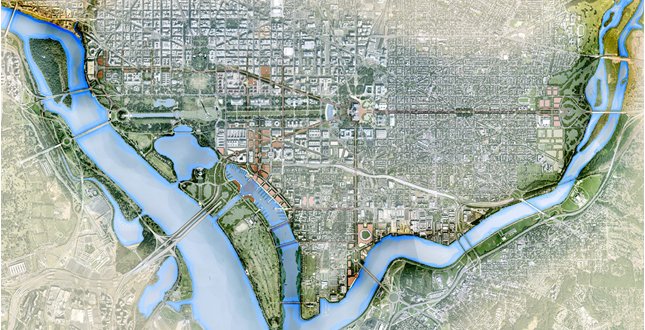 Close Me!
Close Me!The Framework Plan uses bold public realm, land use, and transportation strategies to transform four federal precincts around the National Mall into places of distinct character that will make central Washington more livable and sustainable.
Download Hi-Res ImageImage: AECOM
Image 1 of 14
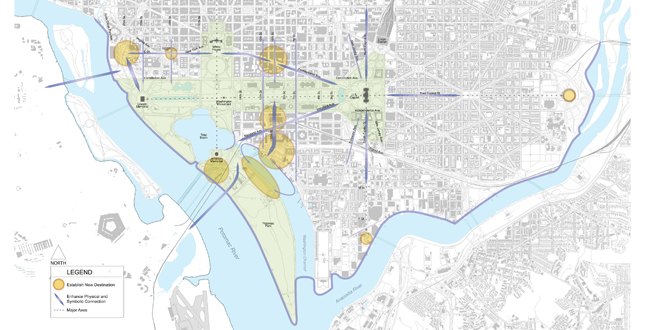 Close Me!
Close Me!The Framework Plan links vibrant new destinations to the National Mall, the center city, and the waterfront through symbolic, physical, ecological, and programmatic improvements, thereby extending the image of the capital city beyond the National Mall.
Download Hi-Res ImageImage: AECOM
Image 2 of 14
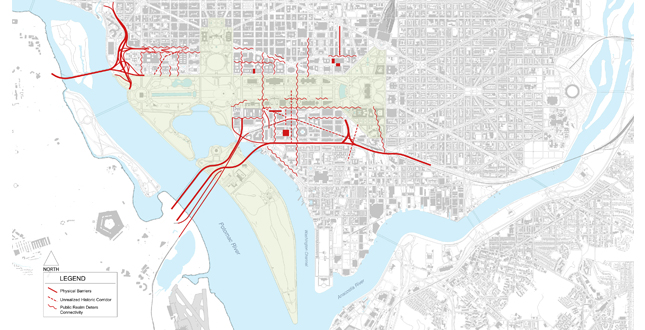 Close Me!
Close Me!Analysis of physical and perceived barriers identifies disruptions that isolate federal precincts and the National Mall from the city. The Framework Plan will re-knit the city's urban fabric through strategic redevelopment, interconnected public spaces, and improved pedestrian experiences.
Download Hi-Res ImageImage: AECOM
Image 3 of 14
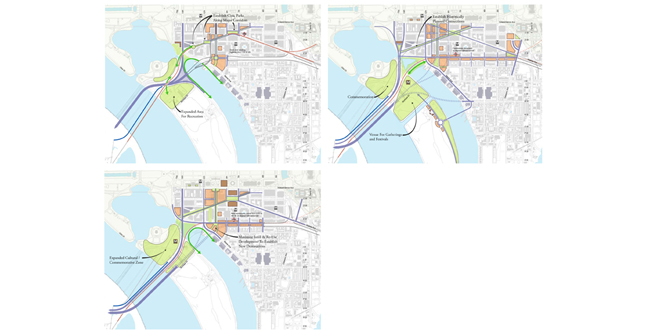 Close Me!
Close Me!Landscape Architects created alternative urban design and connectivity approaches for each of the four precincts surrounding the National Mall. The options were vetted with stakeholders and evaluated against overall goals, environmental benefits and implementation feasibility to derive final recommendations.
Download Hi-Res ImageImage: AECOM
Image 4 of 14
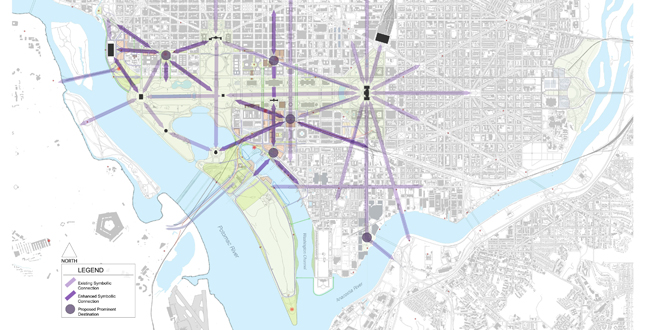 Close Me!
Close Me!Building on the city's planning heritage, the Framework Plan reinforces prominent visual axes, strengthens vistas, and creates new symbolic relationships to establish new locations for civic, cultural, and commemorative destinations.
Download Hi-Res ImageImage: AECOM
Image 5 of 14
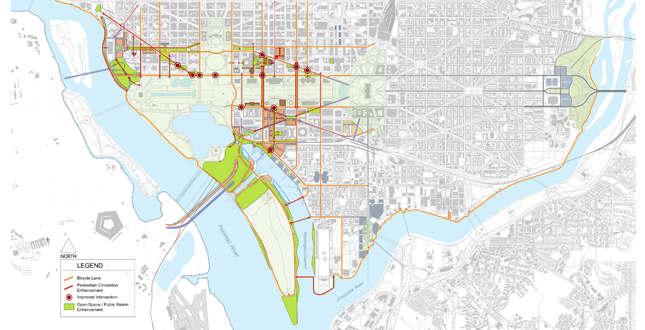 Close Me!
Close Me!The Framework Plan proposes linking mixed-use development clusters, transit hubs, and public parks with pedestrian amenities and an interconnected system of beautiful, sustainable, and functional open spaces and bikeways.
Download Hi-Res ImageImage: AECOM
Image 6 of 14
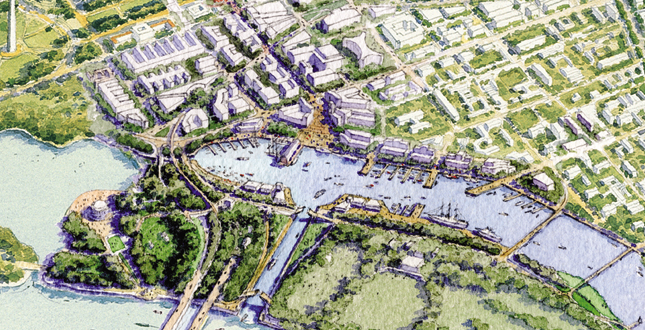 Close Me!
Close Me!Restoring streets, developing over an existing freeway, dredging a canal, and building pedestrian bridges will extend the National Mall landscape to the waterfront, the river, and the city's southern neighborhoods.
Download Hi-Res ImageImage: James Shaughnessy, 1953
Image 7 of 14
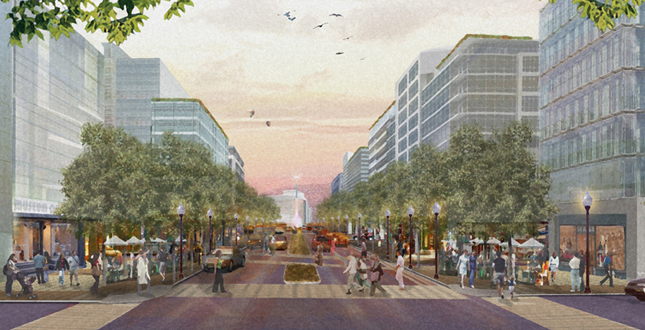 Close Me!
Close Me!Compact, mixed-use redevelopment of the Forrestal Building complex will encourage transit use, establish an inviting and walkable public realm; and reclaim important symbolic vistas and connections for a nationally significant cultural destination.
Download Hi-Res ImageImage: AECOM
Image 8 of 14
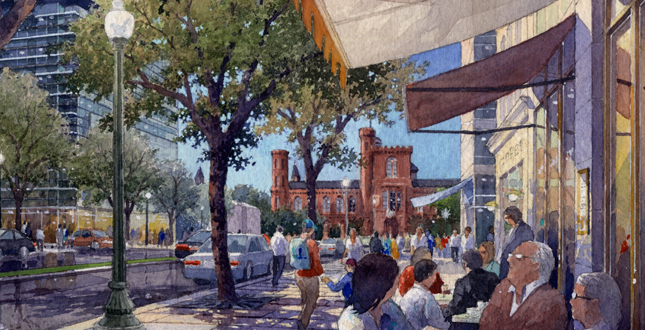 Close Me!
Close Me!The redesign of 10th Street, SW will transform an inhospitable corridor into an economically vibrant and engaging street that includes pedestrian amenities and comfortable gathering spaces for leisure activities and national events.
Download Hi-Res ImageImage: McCann Illustrations
Image 9 of 14
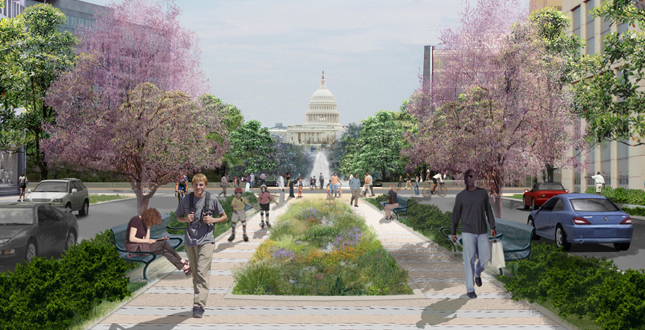 Close Me!
Close Me!Innovative improvements will reestablish Maryland Avenue over an existing rail-corridor, thereby reclaiming a significant L'Enfant square and enhancing urban ecology by reducing the heat island effect, increasing tree canopy, and integrating stormwater management gardens.
Download Hi-Res ImageImage: AECOM
Image 10 of 14
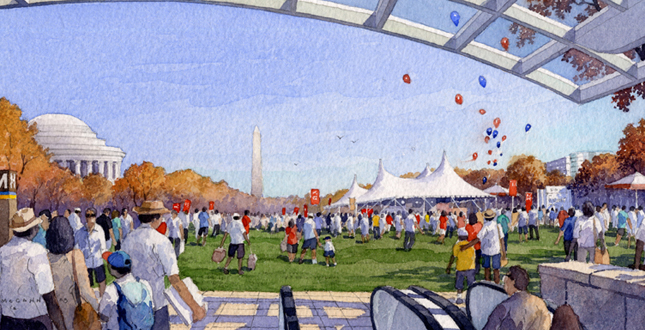 Close Me!
Close Me!Realigning highway ramps and building a new transit station will extend the National Mall beyond an isolated and inaccessible area near the Jefferson Memorial and provide new civic space with a monumental backdrop to accommodate recreation and events.
Download Hi-Res ImageImage: McCann Illustrations
Image 11 of 14
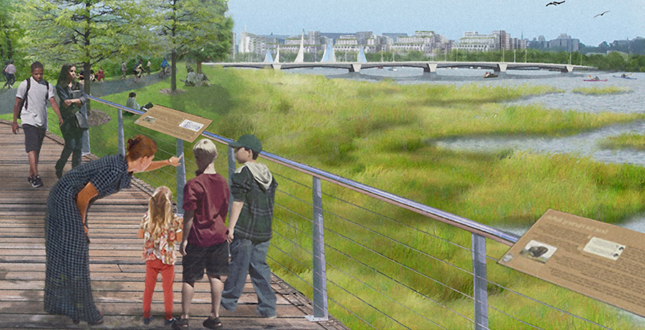 Close Me!
Close Me!Rather than replace a failing seawall along Potomac Park, reshaping the shoreline to create marsh habitat will cleanse the water and mitigate flooding problems, as well as provide a scenic boardwalk and interpretive education opportunities.
Download Hi-Res ImageImage: AECOM
Image 12 of 14
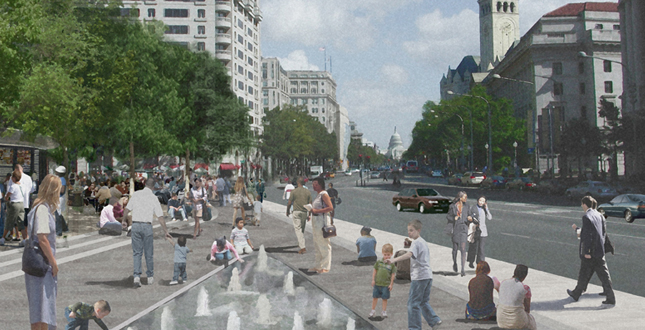 Close Me!
Close Me!Improving the quality and programming of interconnected public spaces will blur the perceived boundaries between downtown and the National Mall and be a more appealing and walkable environment for workers and visitors.
Download Hi-Res ImageImage: AECOM
Image 13 of 14
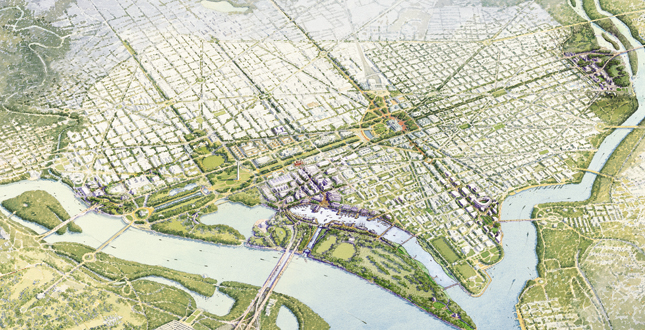 Close Me!
Close Me!Building upon the extraordinary assets of Washington, the Framework Plan employs sustainable urban design and landscape principles to shape the built environment and address social, cultural, economic, and environmental needs of the 21st Century.
Download Hi-Res ImageImage: McCann Illustrations
Image 14 of 14
Project Statement
The Monumental Core Framework Plan (Framework Plan) builds upon the extraordinary assets of Washington, DC to address the social, cultural, economic, and environmental needs of the 21st century. The Framework Plan integrates the civic qualities of the National Mall and urban vibrancy throughout the monumental core. It aims to create locations for future cultural destinations, introduce a mix of uses, revitalize stagnant areas, establish a new “eco-district,” and transform the Washington experience.
Project Narrative
Goals and Objectives
—2011 Professional Awards Jury
The National Mall, with its green expanse framed by iconic buildings and monuments, is the premiere stage upon which Americans display their civic identity. Unfortunately, because of its own popularity, the Mall is overused and overdeveloped. In addition, there are physical and perceived barriers that separate the Mall from the city’s surrounding urban fabric. Recognizing this, the Framework Plan is designed to help preserve the historic landscape of the National Mall as a venue for national gatherings and a place to honor our country’s heroes and cultural heritage. The Plan accomplishes this by identifying new locations and enhancing the settings of nearby prominent sites for future memorials and museums beyond the National Mall.
The Framework Plan also recognizes and responds to several urgent issues that are unique to our nation’s capital and balances them with the interrelated needs of a growing modern city. These include the emerging demand to reconnect the city to its waterfront; the mandate to remove barriers to mobility and development; the call to meet the growing open-space and recreation needs of the District of Columbia; the requirement to properly accommodate the federal government within the monumental core; the challenge of meeting federal building security standards; and the ecological and social imperative of sustainable planning—all within the context of Washington’s expanding downtown.
Symbolism and Cultural Expression
The design of Washington, DC is one of the great artistic achievements of our nation and a living symbol of our civic culture. The city was conceived, planned, and built as the urban expression of our nation’s identity and democratic principles. The Framework Plan recognizes that the location of buildings, memorials, and important civic spaces must contribute to the organizing principles of our city, our democracy, and our evolving national narrative. To relieve the pressure on the National Mall, the Framework Plan proposes to create new visual and physical connections by enhancing views and symbolic relationships; restoring historic squares and streets; dedicating prominent development sites for primary civic uses; improving access to the waterfront; and establishing a continuous and walkable public realm.
Livability and Sustainability
The Framework Plan promotes sustainable strategies that combine urban design principles with sound environmental practices. It creates mixed-use destinations supported by improved access to multi-modal transportation systems, linked by an expanded network of beautiful parks, plazas, and complete streets. These elements combine to actively improve environmental quality, maximize low-impact development capacity, and encourage transit use, walking, and bicycling throughout the monumental core. The Framework Plan promotes resource conservation and energy efficiency by investing in high-performance buildings, upgrading aging infrastructure with green technologies, and establishing collaborative eco-districts to improve storm water management and promote the sharing of renewable energy. The plan also will improve ecological quality by integrating natural elements into every scale of design and restoring the urban tree canopy, the natural shoreline, and native habitats.
Analysis and Outreach
Landscape Architects organized and managed the process that developed the Framework Plan, crafted its recommendations, secured its approval, and facilitated unprecedented collaboration between federal and District of Columbia agencies. In addition to the two sponsoring commissions, 15 partner agencies contributed to and shaped the Framework Plan recommendations during three years of planning, analysis, and consultations. Simultaneously, the partners hosted public open houses to engage DC residents, convened a panel of sustainability experts to evaluate and refine the recommendations, and sponsored a symposium to obtain input from around the country. The latter included the public and experts in planning, design, urban ecology, history, commemoration, and public policy.
The recommendations were derived by building upon Washington’s strong planning heritage. The Framwork Plan blends traditional principles from the L’Enfant and MacMillan plans and the vision of the 1997 plan, Extending the Legacy, with the dynamic patterns of ecological systems and current economic development strategies to correct some of the unanticipated consequences of past planning and development decisions. Historical maps were overlaid to identify previously planned, but unrealized, streets and squares. These rediscovered landscapes have become the centerpieces of proposed destination clusters. To complement the historical influences, existing hydrological patterns, flood plain dynamics and tree canopy systems were synthesized to target opportunities where redevelopment and open space enhancement could best improve environmental quality.
Action and Implementation
The Framework Plan is a flexible tool to guide federal planning, development, and investment decisions over the next thirty years. Itprioritizes a series of specific initiatives, follow-up studies and next steps that are the first practical step in achieving the long term vision. The two federal commissions that sponsored the Framework Plan adopted it in 2009 and have already started implementation. Beginning with detailed planning for the Southwest Ecodistrict, the first signature destination aimed at relieving pressure on the Mall, Washington is advancing as a 21st Century model for outstanding urban design, livability, and sustainability. In addition, a new presidential memorial is being designed in the area by Frank Gehry.
Project Resources
National Capital Planning Commission
Executive Director: Marcel Acosta;
Chief Operating Officer: Barry Socks;
Director, Plan and Project Implementation: William Dowd;
Director, Office of Public Affairs: Lisa MacSpadden;
Project Team: Elizabeth Miller, ASLA, Project Manager;
Stefanie Brown; Shane Dettman; Paul Jutton; Roszonna Whitsett
Commision of Fine Arts
Project Team: Thomas Luebke, Principal Advisor;
Sarah Batcheler; Frederick Lindstrom;
Tony Simon
AECOM
Principal: Alan Harwood;
Project Manager: Ryan Bouma, ASLA;
Team: Jennifer O’Brien; Cary Simmons; Luke Sinopoli; Manqing Tao
McCANN ILLUSTRATIONS
Illustrator: Michael McCann
BDL COMMUNICATIONS
Contributing Writer: Denise Liebowitz,
National Capital Planning Commission
Chairman, Presidential Appointee: John V. Cogbill, III;
Presidential Appointee: Herbert F. Ames;
Presidential Appointee: John M. Hart;
Mayoral Appointee: Arrington Dixon;
Mayoral Appointee: Stacie S. Turner;
Secretary of Defense: The Honorable Dr. Robert E. Gates, Represented by Ralph E. Newton;
Secretary of the Interior: The Honorable Ken Salazar, Represented by Peter May;
Acting Administrator of General Services: The Honorable Paul F. Prouty, Represented by Michael McGill;
Chairman, Committee of Homeland Security and Governmental Affairs, United States Senate: The Honorable Joseph I. Lieberman, Represented by Deborah Parkinson;
Chairman, Committee on Oversight and Government Reform, United States House of Representatives: The Honorable Edolphus Towns, Represented by Mark Stephenson;
Mayor, District of Columbia: The Honorable Adrian M. Fenty, Represented by Harriet Tregoning;
Chairman, Council of the District of Columbia: The Honorable Vincent C. Gray, Represented by NCPC Vice Chairman: Robert E. Miller
US Commission of Fine Arts
Chairman: Earl A. Powell III;
Vice Chairman: Pamela Nelson;
Diana Balmori, ASLA; John Belle; N. Michael McKinnell; Elizabeth Plater-Zyberk; Witold Rybczynski, Honorary ASLA






